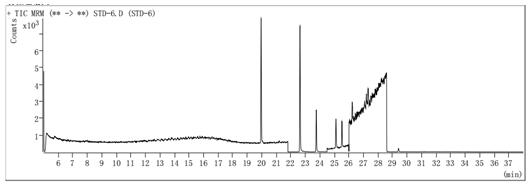Method for detecting 10 halogenated carbazole compounds in marine sediments
A technology for marine sediments and substituted carbazoles, which is applied in the field of marine sediment detection, can solve the problems of unknown properties of halogenated carbazoles and limited halogenated carbazoles, and achieve the promotion of quality and safety, high sensitivity, and increased The effect of export volume
- Summary
- Abstract
- Description
- Claims
- Application Information
AI Technical Summary
Problems solved by technology
Method used
Image
Examples
Embodiment 1
[0058] 1. A method for detecting 10 halogenated carbazole compounds in marine sediments, comprising:
[0059] 1.1 Configuration standard product:
[0060] Weigh the above 10 standard halogenated carbazole compounds of the same mass and mix them, and prepare a mixed solution with a mass concentration of 1000 mg / L using acetone as a solvent. Prepare 10mg / L standard stock solution and store at -20℃; Dilute the standard stock solution with acetone to the concentration of 0.1ng / mL, 0.2ng / mL, 0.5ng / mL, 1ng / mL, 2ng / mL respectively , 5ng / mL, 10ng / mL, 20ng / mL, 50ng / mL, 100ng / mL to obtain a standard series of working solutions, which were stored in a -20°C refrigerator away from light until testing.
[0061] 1.2 Sample collection and processing:
[0062] Sediment samples were collected at the sampling point. The collected sediment samples were first removed of impurities, freeze-dried and placed in a stainless steel box, ground at 30°C, passed through an 80-mesh sieve, freeze-dried, a...
Embodiment 2
[0088] 1.3.1 Preparation of silica gel microspheres: Mix 60 mL of water, 20 mL of ethanol, and 14 mL of 0.67 mol / L ammonia water evenly, add 15 mL of ethyl orthosilicate dropwise with stirring, and stir for 20 h in a water bath at 25 °C. Under the condition of 48 ℃ water bath, vacuum and rotary steam for 2 hours to obtain silica sol; dilute the silica sol to 130 mL, add 0.3 g of diethylene glycol ether, 1.8 g of formaldehyde, and 4.5 g of urea, stir to completely dissolve, and add hydrochloric acid solution to adjust the value To 1.6, let stand, add enough deionized water to stop the reaction after the solution turns completely white, stand for 12 hours, filter the white precipitate at the bottom, wash with water and ethanol in turn, dry in a vacuum drying oven at 90°C for 24h, 110°C Dry for 24h, then put it into a muffle furnace for calcination, keep at 150°C for 4h, 250°C for 6h, 350°C for 8h, 450°C for 10h, and 550°C for 12h to obtain white silica gel microspheres. The rest...
Embodiment 3
[0090] 1.3.1 Preparation of silica gel microspheres: Mix 60 mL of water, 20 mL of ethanol, and 14 mL of 0.67 mol / L ammonia water evenly, add 15 mL of ethyl orthosilicate dropwise with stirring, and stir for 20 h in a water bath at 25 °C. Under the condition of 48 ℃ water bath, vacuum and rotary steam for 2 hours to obtain silica sol; dilute the silica sol to 130 mL, add 1.5 g of diethylene glycol ether, 1.8 g of formaldehyde, and 4.5 g of urea, stir to dissolve it completely, and add hydrochloric acid solution to adjust the value To 1.6, let stand, add enough deionized water to stop the reaction after the solution turns completely white, stand for 12 hours, filter the white precipitate at the bottom, wash with water and ethanol in turn, dry in a vacuum drying oven at 90°C for 24h, 110°C Dry for 24h, then put it into a muffle furnace for calcination, keep at 150°C for 4h, 250°C for 6h, 350°C for 8h, 450°C for 10h, and 550°C for 12h to obtain white silica gel microspheres. The r...
PUM
| Property | Measurement | Unit |
|---|---|---|
| correlation coefficient | aaaaa | aaaaa |
Abstract
Description
Claims
Application Information
 Login to View More
Login to View More - R&D
- Intellectual Property
- Life Sciences
- Materials
- Tech Scout
- Unparalleled Data Quality
- Higher Quality Content
- 60% Fewer Hallucinations
Browse by: Latest US Patents, China's latest patents, Technical Efficacy Thesaurus, Application Domain, Technology Topic, Popular Technical Reports.
© 2025 PatSnap. All rights reserved.Legal|Privacy policy|Modern Slavery Act Transparency Statement|Sitemap|About US| Contact US: help@patsnap.com



